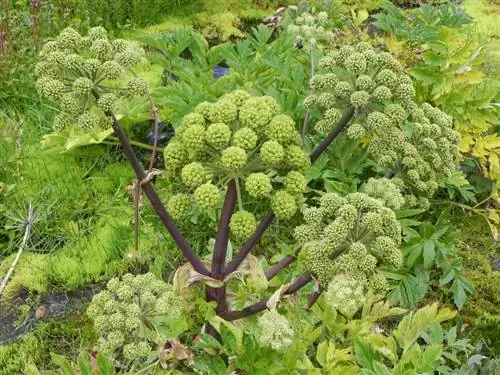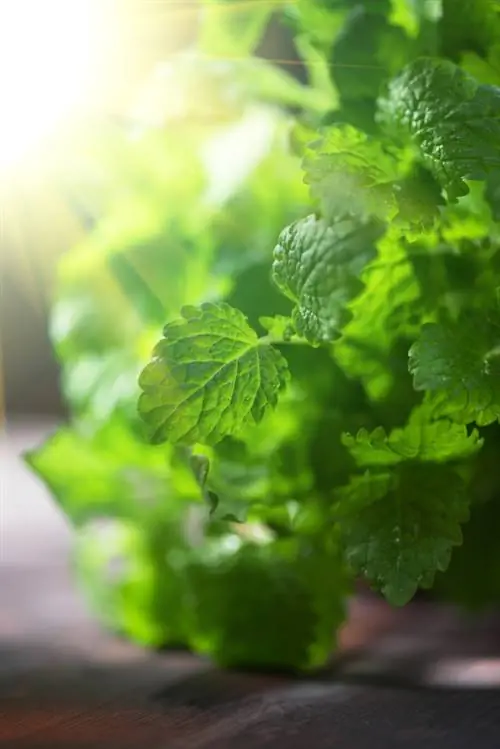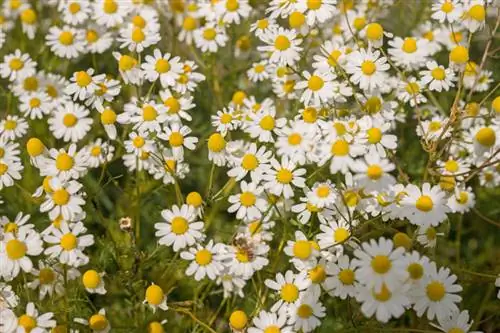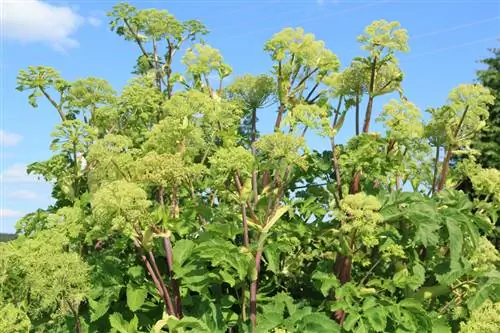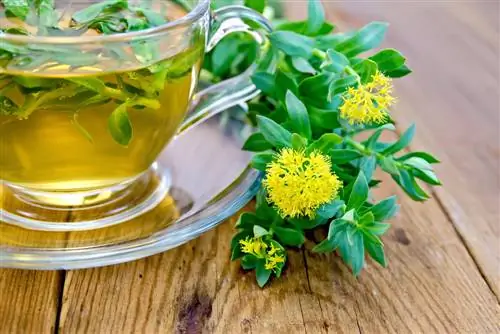- Author admin [email protected].
- Public 2023-12-25 17:45.
- Last modified 2025-01-23 11:22.
An integral part of every monastery and farm garden since the Middle Ages, angelica should not be missing in modern, natural plantings. The outstanding medicinal and herbal plant also impresses as a magnificent structure builder in creative green spaces. We have compiled answers to fundamental questions about cultivating Angelica for you here.
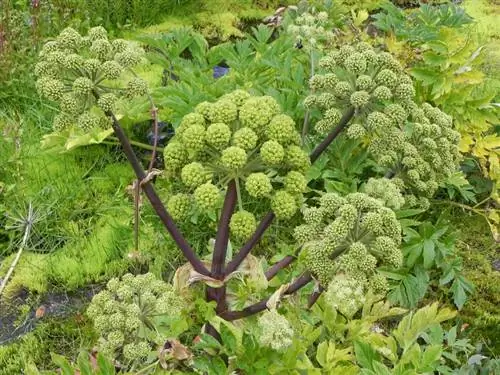
How to care for angelica?
Angelica prefers a sunny to partially shaded location with nutrient-rich, fresh, moist soil. During the course of cultivation, the plant requires regular watering and fertilization. Flowering usually occurs in the second year, after which the plant dies.
Planting angelica correctly
Plant Angelica in a sunny, nutrient-rich and fresh, moist location. No other umbelliferous plants should have been cultivated here in the previous 4-5 years in order to counteract the accumulation of diseases and pests. While the root ball of the young plant is soaked with water, prepare the soil to be finely crumbly and free of weeds or stones. The planting itself is completed in no time:
- Dig a spacious planting pit to enrich the excavation with compost and horn shavings
- Unpot the young Angelica and pull the root ball apart slightly with your hands
- Insert the angelica root while maintaining the previous planting depth and water generously
A mulch layer of comfrey leaves, leaves or grass clippings makes a valuable contribution to the growing process. In dry weather, the freshly planted Angelica is watered regularly so that the roots take root quickly.
Care tips
As part of the planting process, the focus is on providing angelica with plenty of water and nutrients. These two aspects also act as supporting pillars of professional cultivation in the further care program. This is how growth and flowering go as desired:
- Between planting and mid-July, weed thoroughly every few days until the leaves cover the ground
- Prince young Angelica several times for bushy, well-branched and compact growth
- If there is no rain, water repeatedly and generously without causing waterlogging
- From May until the end of the flowering period, fertilize every 14 days with compost, bark humus and comfrey manure
If you mulch regularly with grass clippings, nettle and comfrey leaves or leaves, this measure will keep the soil moist and warm for longer.
Which location is suitable?
In a sunny to partially shaded location, you will enjoy an impressive Angelica and reap a rich harvest. In combination with fresh, moist soil, rich in nutrients and endowed with vital soil life, angelica demonstrates its good reputation as a medicinal, spice and ornamental plant. Please consider the crop rotation for umbelliferous plants and only choose a location where no other member of this family has settled in the previous 4-5 years.read more
The correct planting distance
Adjust the planting distance to the growth width and height, creating a harmonious and seamless appearance of angelica in the bed. So that the expansive Angelica can present itself to perfection, we have put together a brief overview of the planting distances for the most popular species:
- Red angelica with a growth height of 80-100 cm: planting distance 100 cm
- Large angelica with a growth height of 100-150 cm: planting distance 150 cm
- Real angelica with a growth height of 150-250 cm: planting distance 200-250 cm
What soil does the plant need?
In order for angelica to develop its enormous biomass, it requires nutrient-rich, humus-rich and fresh, moist soil. The sunnier the location, the more balanced the soil should be with water without the risk of waterlogging. Angelica feels perfectly at home in the nutritious soil of a pond bank.
What is the best time to plant?
For a young plant in a container, planting time is throughout the entire frost-free garden season. Angelica receives the best conditions for magnificent growth when planted in sun-warmed soil from August to October. Then you can look forward to the flower balls of the two-year-old plant next summer and harvest aromatic leaves and rich stems.
When is flowering time?
Angelica species usually present their unnatural flowers in their second year, only to then die off. The real angelica (Angelica archangelica) starts with a flowering period from June to August. Magnificent specimens, such as the purple angelica (Angelica sylvestris), take a little time and bloom from July to September. The lateral flower umbels underline the impressive habit with greenish, white, pink or red sepals.
Cut angelica properly
Following her first and only flower, Angelica goes to seed to gradually die back. If seeding in the garden is not desired, cut off the flower balls in good time. Otherwise, wait for this process to cut angelica close to the ground. Pruning for the harvest begins well before the flowering period. This means that the stems are nice and tender for candying if they are cut when the inflorescences sprout. Shortly before flowering, the leaves are at the zenith of their valuable content and are cut for use as a medicinal and culinary herb.
Watering angelica
Don't let angelica go thirsty, as drought stress can mean a premature end to the plant's life. On dry summer days, water early in the morning and again in the late evening if necessary. The moisture content of the substrate in the bucket should be checked daily so that if the surface is dry, water immediately. If there is frost in winter, provide the plant with a good drink of water on mild days.
Fertilize angelica properly
In order to develop the huge biomass, the soil does not fully cover the high demand for nutrients. Therefore, fertilize Angelica in the bed with compost and horn shavings every 14 days from April/May until the end of the flowering period. Since the plant explicitly hungers for potassium, supplement the compost with comfrey manure. In large buckets, weekly fertilization with a liquid, organic preparation is recommended.
Wintering
Angelica is completely hardy. Real angelica can easily tolerate temperatures down to -40 degrees Celsius. Decorative varieties can still withstand cold temperatures down to -28 degrees. Therefore, no special precautions need to be taken in the bed. Nevertheless, keep an eye on the weather for cold frost. In bitter cold without snowfall, the plant can become drought-stressed. Therefore, water Angelica on mild days in winter.
Propagate angelica
Before Angelica dies, she diligently ensures that there are lots of offspring through insemination. Ideally, you let nature take its course and simply thin out too many seedlings later. It is also possible to dig up seedlings from a height of 10-15 cm in order to place them in the ground at the desired location. Last but not least, sowing serves as a classic method of propagating Angelica. This is how you can grow it behind glass from mid-February to early April:
- Put the fresh seeds in a bag with damp sand and close it
- Store in the vegetable compartment of the refrigerator for 4 to 6 weeks
- Then sow in seed soil and cover with vermiculite
- Keep constantly moist in the indoor greenhouse at 25 to 30 degrees Celsius
- After emergence, reduce the temperature to 16 degrees Celsius
Growing from the beginning of July by sowing is also possible if you aim to plant in August. In this case, however, the previous stratification cannot be dispensed with.
Angelica in a pot
Caring for Angelica in a pot turns out to be far more complex than in a bed. Since the plant requires water almost every day in summer and needs to be fertilized regularly, only a few hobby gardeners opt for this version of keeping it. Choose a container that offers enough space for the powerful beet roots. As a substrate, we recommend a high-quality compost-based pot plant soil, which is filled over a drainage made of pottery shards or grit. To avoid wind throw, an appropriately protected location should be chosen for the mighty Angelica. Last but not least, the additional effort required for successful wintering speaks in favor of a bed culture. To prevent the root ball from freezing in the exposed position of the pot, it should be covered with foil and placed on insulating material.
Is angelica poisonous?
Regardless of its highly praised medicinal properties and the aromatic taste of its flowers, leaves, stems and roots, the care and planting work still poses a toxic risk. If the skin comes into contact with the plant sap while simultaneously being exposed to sunlight, there is a risk of a phototoxic skin reaction. Therefore, always wear gloves when handling angelica in the open air or in a sunny kitchen.
Angelica doesn't bloom
Don't be surprised if angelica doesn't produce its large ball flowers in its first year. The biennial plant concentrates on developing sufficient leaf mass in its first year. Only in the following year is the plant energy required to bloom in white, pink or red. As a result, the plant dies after it has self-sowed to provide suitable offspring.
How and when is angelica harvested?
The rule of thumb for harvesting Angelica is: once the plant is in flower, the quality of the leaves, stems and roots suffers enormously. So harvest angelica like this:
- Harvest angelica stems as soon as the inflorescence sprouts in spring
- Cut off the aromatic leaves shortly before flowering
- The best time to harvest the roots is also before flowering
If you have the valuable seeds in your sights, wait for them to ripen and hold a paper sack under the mighty umbels. The rich seeds fall in by shaking vigorously. When harvesting the roots, make sure that no more than 5 percent of the green parts of the plant mix with them in order to maintain the desired quality.
How can angelica be identified?
Anyone looking for angelica in the wild should be familiar with its visual characteristics. Look for the following characteristics that clearly identify a plant as Angelica:
- Large, ball-shaped umbel flowers in greenish-white, pink or red
- Flowering period of Angelica from May to September
- Mighty, hollow flower stalks up to 200 cm high
- Leaves appear bi- or tri-pinnate, with light green blades
Include your nose when identifying angelica, as the flowers exude a pleasant honey scent. If you break off a stem and rub it between your gloved fingers, it smells of musk and oranges.read more
Beautiful varieties
- Vicar’s Mead (Angelica sylvestris): Premium variety with pink flowers and majestic stature; Growth height 90-120 cm
- Solveig (Angelica archangelica): Real angelica scores with high healing properties and delicious taste; Growth height 250 cm
- Large angelica (Angelica giga): magnificent specimen with dome-like flowers in rich red; Growth height up to 160 cm

